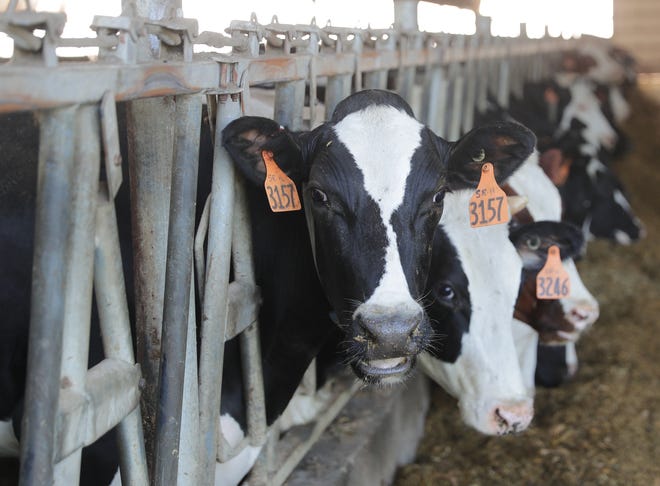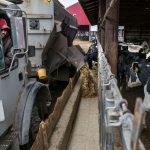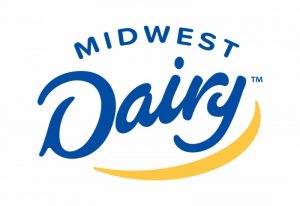
Even though the situation in the industry remains tough, Mark Stephenson, head of dairy policy analysis at the University of Wisconsin-Madison, said “2020 was not as bad a year for dairy farmers.”
Here is look at the numbers:
The beginning was rough — milk prices plummeted in early 2020
Milk prices had been low since 2015 — “for a longer period of time than we’ve seen in quite a while,” according to Stephenson. Farmers did their best to cut costs, and waited for demand to increase and boost prices with it.
In 2019, prices were finally starting to climb. By November, prices reached $22.5 per 100 pounds of milk, the highest level since 2014.
But as the news of the coronavirus crept in, prices didn’t stay high. According to Stephenson, by mid-January 2020, the futures market saw a big drop overnight. There hadn’t been COVID cases confirmed in the U.S., but there were fears that it would impact dairy export sales to China, the world’s largest importer.
On top of that, there was already news about China’s partial quarantine and port closures, which were delaying the unloading of ships.
After the U.S. saw its first confirmed COVID case in Washington state, it wasn’t long before many cities went into lockdown.
In the U.S., about half of milk production is consumed outside the home, from restaurants to schools. That demand suddenly disappeared during stay-at-home guidelines. From November 2019 to May 2020, milk prices dropped 39% to $13.7 .
Some Wisconsin farmers were forced to dump milk and some co-ops restricted milk production. “It was a difficult time for farmers,” Stephenson said.
Percentage change in monthly milk production among the top six dairy states, compared to the same month the previous year
In early 2020, many major dairy states saw cutbacks in production due to the price drop.
While some states, even then, were able to expand production compared to the same months in the previous year, Wisconsin saw a major decline.
For four months in a row, November 2019 to February 2020, and another three months in a row, April to June 2020, Wisconsin produced less milk than the same month in the previous year.
The industry turned the corner in mid-2020, when demand increased after the government passed COVID stimulus bills that included food-box programs with dairy products. Prices started going back up by July.
The states continued to expand milk production for the rest of the year, and all six top states ended up producing more milk in 2020 than in 2019.
But the cost of producing milk and maintaining farms has also risen.
The USDA’s milk production cost estimates show the total cost has been on the rise; in 2020, it was $22.87 per hundredweight in Wisconsin, up from $20.76 in 2016. What’s more, milk prices may have somewhat higher at the moment, but its instability complicates the situation.
“Our input costs are always going up. But then our price is all over the place, and definitely not staying in tune with how the input costs are rising,” said Sarah Lloyd, a dairy farmer in Wisconsin Dells. “Our input costs are not being covered, and it’s even getting harder to do that.”
Even so, the higher milk prices, in combination with the government’s direct payments to farmers under the coronavirus food assistance programs, helped some Wisconsin dairy farms. Not as many farms closed last year, compared to some previous years.
According to the USDA, in July 2021, there were 6,755 milk cow herds in the state, about half as many as in 2008.
In 2019, when the state lost more than 800 dairy farms, the attrition rate was as high as about 10%. The rate considered “normal” is somewhere between 3.5 to 4% annually.
“That’s a crisis,” Stephenson said.
Last year, Wisconsin lost 360 dairy farms, an attrition rate of about 4.9%.
With new technologies and improved genetics, as well as fewer people drinking milk, Stephenson said it is inevitable that bigger farms will continue to consolidate, forcing out smaller ones.
“If we’re losing 3 to 4% of farms, that’s probably farms that are just at the end of a life’s stage,” he said.
Some farmers are encouraging their children to leave the industry, noted Darin Von Ruden, president of Wisconsin Farmers Union: “There’s so many dairy farmers out there, over the past two to three decades, that have encouraged their kids to leave and get away.”
Von Ruden said more farms are pressured to expand their operation in order to stay in business, and until there is a sustainable model for family farmers, “we’re going to continue seeing that 5 to 10% loss,” he said.
Farmers say the industry needs a long-term solution

The picture from 2020 may seem better, but the crisis continues.
While the extra money the farmers gained last year helped stabilize many operations, “it’s not like a long-term solution,” according to Lloyd. Many farmers took out more loans with the money last year, she said, “trying to catch up or not fall off the track, so I don’t think that our 2020 was really any different than that.”
“If I have five years of bad prices,” she said, “I need five years of good prices to make up for the hole that I dug myself.”























